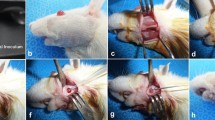Abstract
The standard treatment of chronic skull-base osteomyelitis is antibiotics and surgical removal of sequestrums. Hyperbaric oxygen therapy has been found to be a useful method for managing refractory cases of chronic osteomyelitis. Since a minimal blood supply is needed for hyperbaric oxygen therapy, chronic osteomyelitis can produce necrotic infected areas that are not nutrified and therefore not assessible for hyperbaric oxygen therapy. Ozone is known to be an oxidizing medium with a strong bactericidal effect. We investigated the influence of locally applied ozonated oxygen on the development of chronic osteomyelitis in an experimental animal model using the femur of the rabbit. The proximal sides of the femurs of 40 rabbits were prepared and a needle inserted into the intramedullary cavity. Osteomyelitis was induced with an infusion of Staphyloccus aureus and sodium morrhuate into the bone. The needle was left in a intramedullar location. After a 4-week delay animals were randomly separated into treatment and control groups. The infected femur of treated animals was flushed three times a day with 20 ml of ozonated oxygen at an ozone concentration of 107 μg/ml O2 over periods of 2 or 4 weeks. Clinical, radiographic and microbiological findings were documented. Chronic osteomyelitis occurred in all animals. Ten rabbits were excluded from further study during the investigation because of excessive weight loss (>15% of the original weight). Bacterial cultures showed no significant reduction of S. aureus concentrations in the ozone-treated group, although comparison of radiographic results revealed less serious osteomyelitis-related bone damage in these animals (P < 0.01). These findings indicate that refractory osteomyelitis in the head and neck may benefit from locally applied “flush” therapy with ozonated oxygen in addtion to treatment with antibiotics, surgery and hyperbaric oxygen.
Similar content being viewed by others
Author information
Authors and Affiliations
Additional information
Received: 17 September 1997 / Accepted: 4 June 1998
Rights and permissions
About this article
Cite this article
Steinhart, H., Schulz, S. & Mutters, R. Evaluation of ozonated oxygen in an experimental animal model of osteomyelitis as a further treatment option for skull-base osteomyelitis. European Archives of Oto-Rhino-Laryngology 256, 153–157 (1999). https://doi.org/10.1007/s004050050130
Issue Date:
DOI: https://doi.org/10.1007/s004050050130




